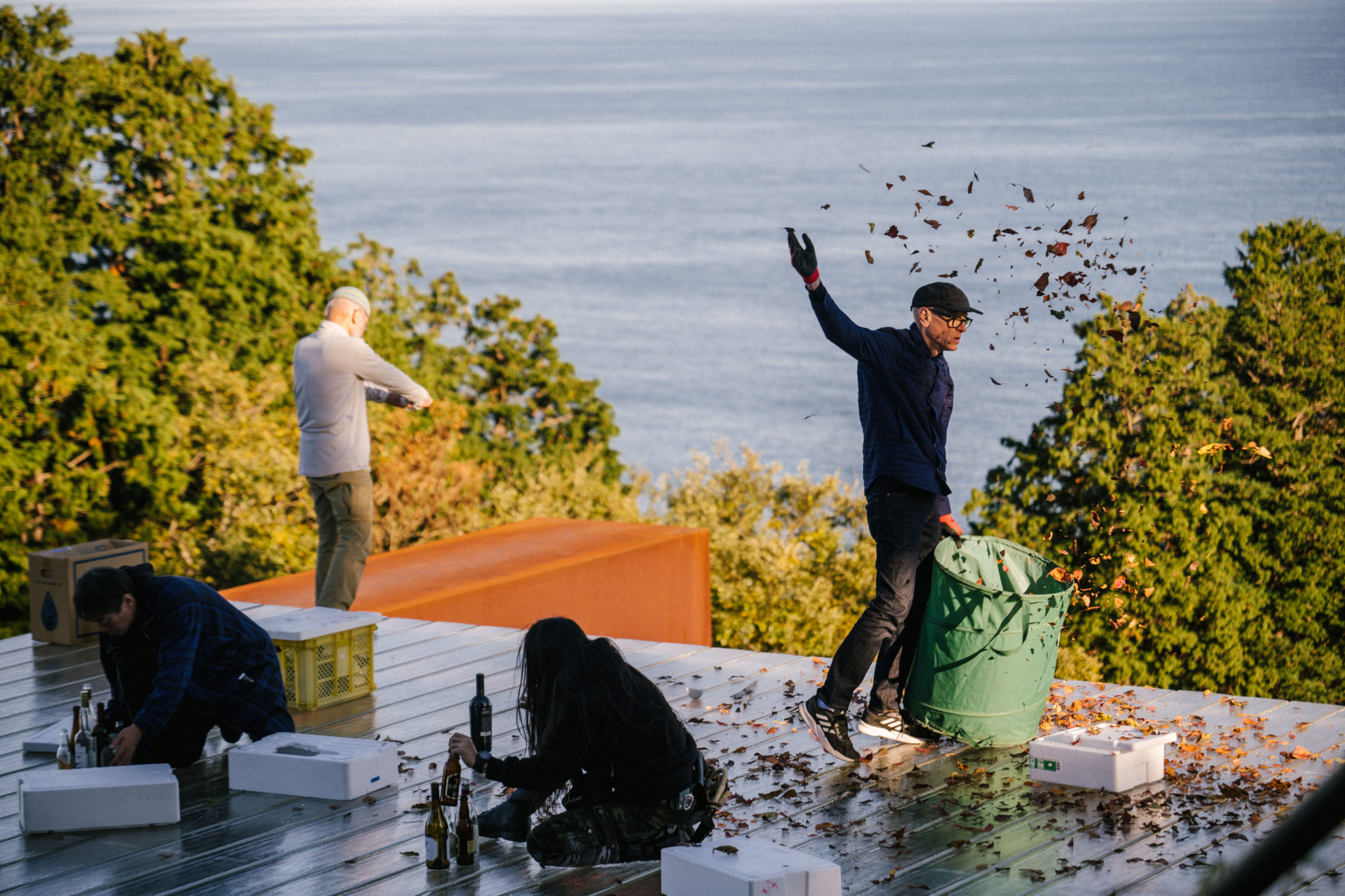Born in 1980, Yuko Mohri is an artist who eschews a composition-based approach, creating mainly installations and sculptures focused on phenomena that change in response to the surrounding environment and other conditions. In addition to recent solo exhibitions including “Parade (a Drip, a Drop, the End of the Tale)” (Japan House São Paulo, 2021), “SP. by yuko mohri” (Ginza Sony Park, Tokyo, 2020), and “Voluta” (Camden Art Centre, London, 2018), her work has appeared at the 34th São Paulo Biennial, Glasgow International 2021, the 2018 Asia Pacific Triennial (in Brisbane), the 2017 Lyon Biennale, and several other exhibitions around the world. Mohri undertook a residency in the United States as an Asian Cultural Council grantee in 2015, and is set to travel to France in 2022 as laureate of the Institut français Cité internationale des arts 2020. https://www.mohrizm.net/
photo: Timothee Lambrecq ©Odawara Art Foundation
“Found in Odawara,” a sound performance by Christian Marclay, took place on November 27 and 28. The event was one of the programs arranged in conjunction with “Christian Marclay Translating,” Marclay’s solo exhibition at the Museum of Contemporary Art Tokyo, for which the artist himself visited Japan after clearing the COVID-19 quarantine procedures required to enter the country.
I had last visited the Enoura Observatory in Odawara on November 1, 2019, for a project by Tino Sehgal. Over the two years since, Hiroshi Sugimoto has made a number of changes to the venue. A sign bearing the words “Citrus Mountain” stands at the back of the parking lot, and from behind the placard starts a path that leads up to a café called Stone Age, which serves refreshments made from citrus fruits grown on the premises. As I sat there with an acquaintance, someone I hadn’t seen in a long time but had run into by chance that day, drinking hot lemonade and looking out toward the sea and the blue sky, I saw dark clouds rolling in from the west and rain falling far away over the open water.
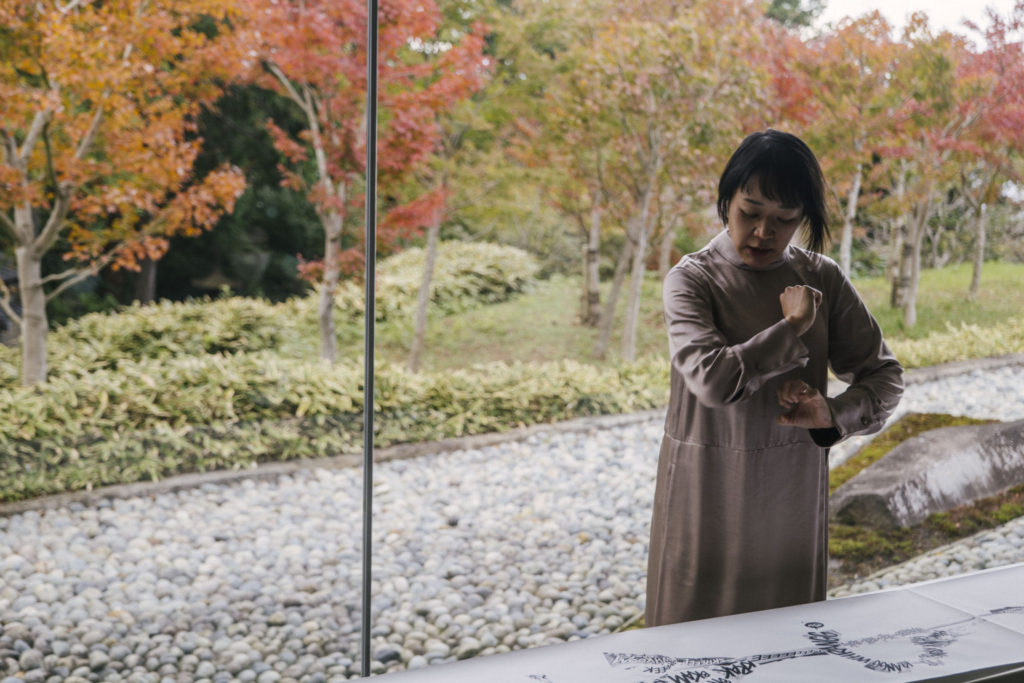
photo: Timothee Lambrecq ©Odawara Art Foundation
Us participants were eventually led into the Summer Solstice Light-Worship 100-Meter Gallery, a three-meter wide and, as the name suggests, 100-meter long building. Making use of the structure’s shape, long tables were set up inside it and on them, like a picture scroll, was laid out Marclay’s “Manga Scroll.” The artwork, also on display at the Museum of Contemporary Art Tokyo’s “Translating” exhibition, is a collage composed from onomatopoeic expressions found in manga comic books and doubles as a graphic score for vocalists. Us onlookers were seated with our backs against the wall, facing the scroll. My place was near the middle and provided a good view of both ends of the score. I opted to view it standing, so as not to brush up against Hiroshi Sugimoto’s “Seascapes” on the wall. The sea and the mountains, bathed in the colors of fall, were visible through the windows on the other side of the “Manga Scroll.” The rain clouds had already blown somewhere far away.
Before things began, the organizers asked the audience to refrain from talking, taking photos, clapping or making other sounds during the performances. A few moments passed, and vocal artist Ami Yamasaki made her appearance. She walked to the far end of the gallery, took a breath, and began her performance. Yamasaki performed the score without a microphone or speakers, using only her vocal chords, mouth, arms and fingertips, occasionally thumping her chest and shoulders. The onomatopoeia lifted from the pages of manga included not only specific sounds such as explosions, the roar of an engine or the dripping of water, but also ones that made it hard to make out the context. Accordingly, Yamasaki’s voice at times made sounds that hardly seemed human echo through the space.
I was reminded of the first time I listened to music on a phonograph. I was once captivated by these acoustic record players, by how they take the vibrations emitted by a needle and amplify them through a horn. The experience was completely different from anything I had come across previously with electronic music media. The volume, weight, and depth of the sound, as well as the noise inherent in it, contained an unstable but elusively attractive quality unique to analog media. To play one side of a standard 78 rpm record, you first have to wind up the spring. Needles come in various sizes, from very sharp ones to ones thicker than the tip of a pencil, and you’d have like 50 of them in a box similar to one that holds staples. Using a thick needle results in a “bigger” sound, since more of the record’s groove is activated, while a sharper, more delicately shaped needle produces a finer, smoother sound. As needles get worn out quickly, you have to replace them after playing only a few tracks. The only way to adjust the volume is to wrap the phonograph with a blanket. That makes for a physical experience entirely different from that you get being surrounded by digital devices. I’d sit on my knees in front of the phonograph just to listen to one side of a record for five minutes. One should never turn on Bluetooth and just drift away while letting the music play endlessly.
Yamasaki’s performance consisted of converting the approximately 20-meter long graphic score into sound all at once, using her entire body without pausing once or relying on amplification. It brought to my mind a needle on a record. Sound, its quality and strength, varies depending on the extent to which the needle (i.e. the performer) touches the record (the score). And as sound is produced, both are worn down. That wear and tear is beautiful—it’s a sign of natural change.
I ran into Yamasaki immediately before the show and heard that she had in fact just finished recording a full choral performance. Giving such an amazingly intense, masterful performance twice a day must require remarkable needle quality (physical fitness).
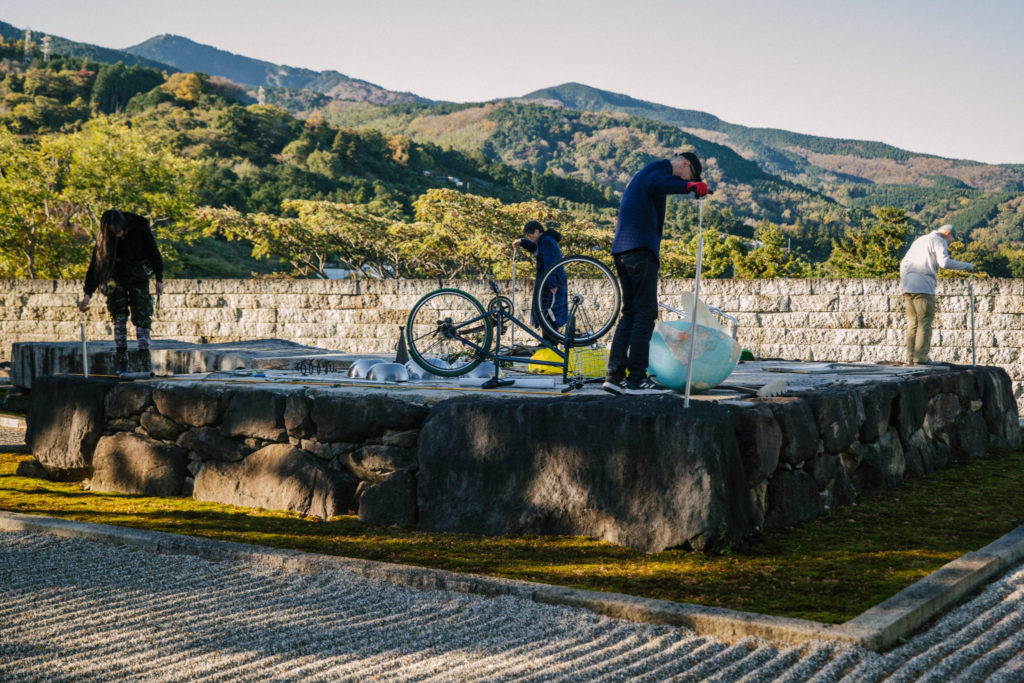
photo: Timothee Lambrecq ©Odawara Art Foundation
Once Yamasaki’s performance was over, we were asked to exit the gallery. Waiting in front of the closed Meigetsu Gate, we heard a drum-like sound coming from beyond the gate. Sugimoto, whom I happened to stand next to, remarked that it sounded like “the assault of the 47 ronin.” Christian Marclay finally opened the gate, producing a sound that resembled parts of its wooden joinery rubbing against each other, and welcomed the audience inside. Yoshihide Otomo and Fuyuki Yamakawa’s performance had already started on the stone Noh stage. Found objects such as a broken bicycle, a tub, a large terrestrial globe, and metal poles lie scattered around them, and the artists produced sound by beating and rubbing on them. Akio Suzuki, standing as if leaning on the stone underneath the stage that supports the Togetsu Bridge, stuck the end of a long tube into a puddle that had accumulated in a cavity before taking it out again. As water filled the tube, the amount of air in it was reduced, making a splashing sound whose echo became ever so slightly distorted.
The wide-open space made it possible to pick up minuscule changes in the sound, despite the fact that no microphones or speakers were used. Before the event, the organizers had asked the audience to refrain from talking, taking photos, clapping or making other sounds during the performances. Each one of these shows would certainly have been worthy of cheers, but they also quickly made me aware of the importance of small acoustic sounds.
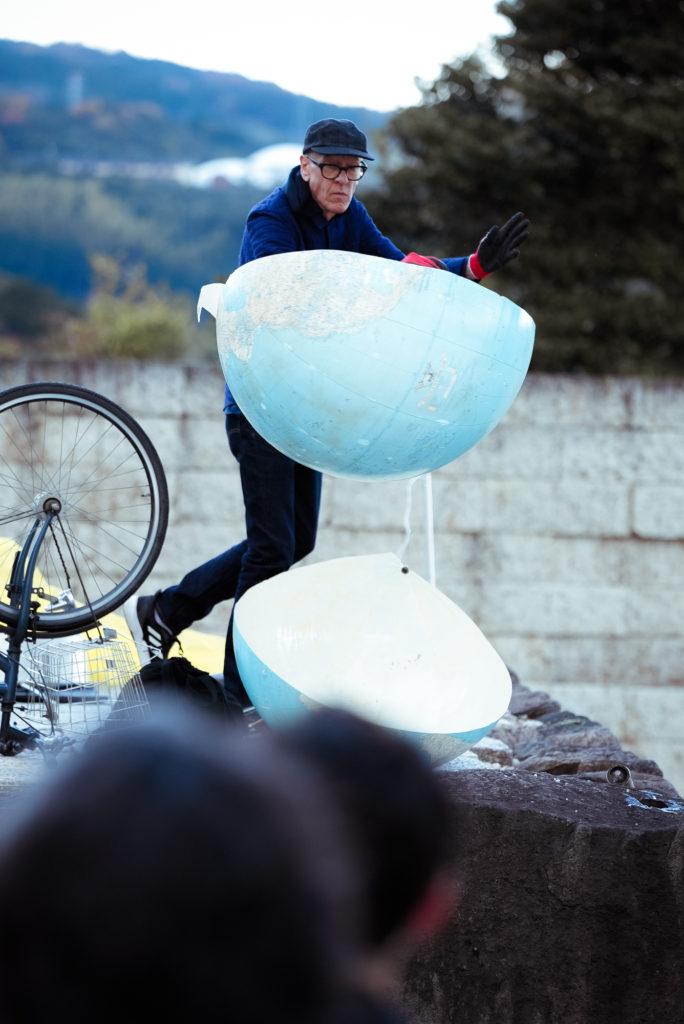
photo: Changsu ©Odawara Art Foundation
All of a sudden, the plastic, roughly 120 cm-wide globe Marclay was holding was thrown off the stage and spectacularly shattered on the gravel it fell on. Us onlookers were surprised by this unexpected turn of events, but Marclay appeared unaffected. His hands now empty, the artist grabbed a sand rake and proceeded to arrange the globe’s pieces into ripples, whirlpools, and other patterns in the gravel, as if fashioning an improvised Zen garden out of them. The remnants of the broken globe were converted into islands in their own little universe. This very moment was one of the highlights of the performance, and an example of Marclay’s “translation” at its best.
As anyone who’s seen “Translating” will attest to, Marclay’s oeuvre obviously cannot be described simply as translation of invisible music into visible impressions. If his work is to be understood through the word “translation,” that process would be more accurately described as translating impressions that appear to represent music (or phenomena) into “something” represented by impressions when they are stripped of (e.g. musical) meaning. Though the reference itself may sound cliché, that evokes Walter Benjamin’s example of a vessel and its fragments in “The Task of the Translator.”
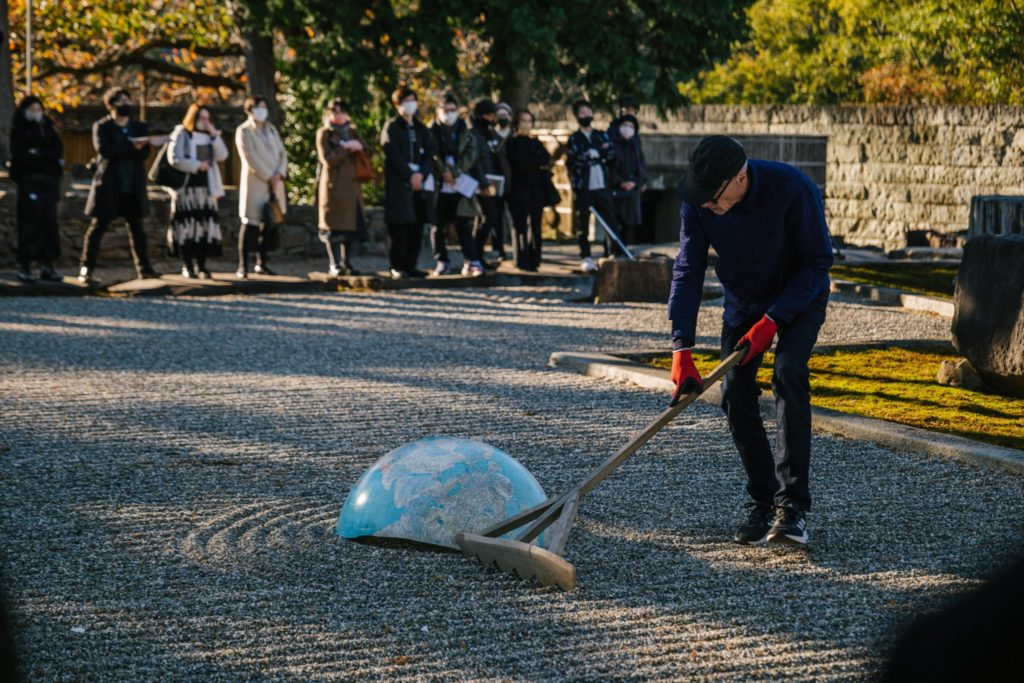
photo: Timothee Lambrecq ©Odawara Art Foundation
“Fragments of a vessel which are to be glued together must match one another in the smallest details, although they need not be like one another. In the same way a translation, instead of resembling the meaning of the original, must lovingly and in detail incorporate the original’s mode of signification, thus making both the original and the translation recognizable as fragments of a greater language, just as fragments are part of a vessel. For this very reason translation must in large measure refrain from wanting to communicate something, from rendering the sense, and in this the original is important to it only insofar as it has already relieved the translator and his translation of the effort of assembling and expressing what is to be conveyed.” (Walter Benjamin: “The Task of the Translator.” Trans. Harry Zohn)
In this case, what Marclay exhibits is the “commitment to word-by-word literalness” that Benjamin has in mind throughout “The Task of the Translator”—what Hölderlin accomplished with his translations of the Greek tragedies of Sophocles. And if so, it’s only natural that Marclay’s art is reflexive (i.e. self-referential) and that his finished works are imbued with a strange practicality.
The performance in which the broken globe was transformed into a miniature universe in the form of a Zen garden pointed to a future in which the world, split into fragments by the pandemic, will remain unintegrated and local, thereby giving rise to an array of new relationships. As such, it somehow felt comforting.
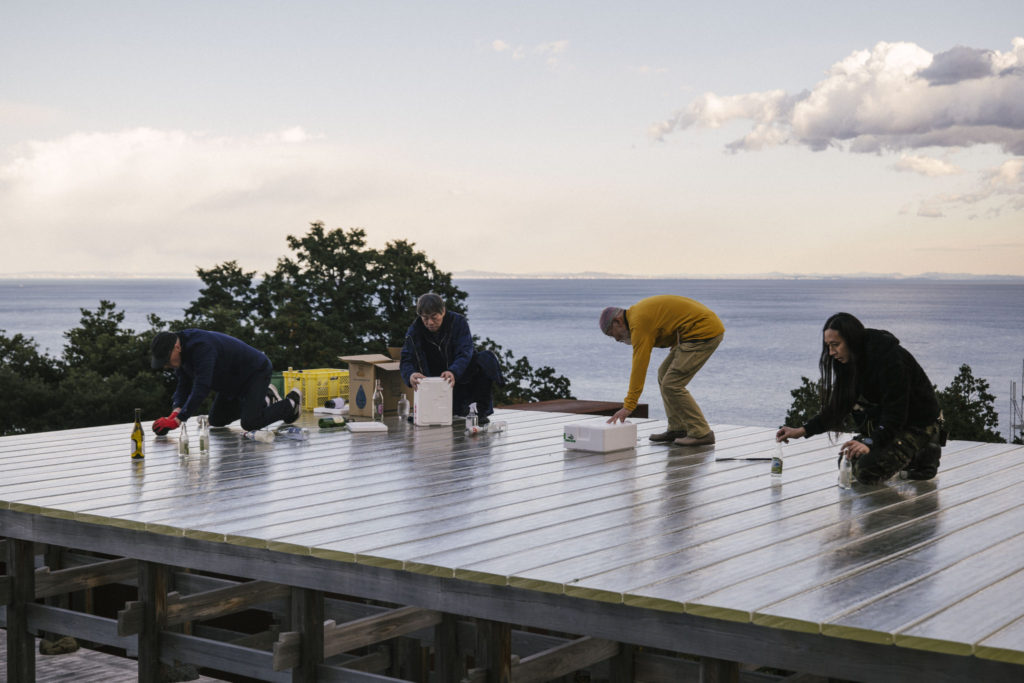
photo: Timothee Lambrecq ©Odawara Art Foundation
From the stone stage, we were led past the “Optical Glass Stage” and through the “Winter Solstice Light-Worship Tunnel” into a bamboo grove. The performers, standing on a bamboo-covered cliff, threw items such as pebbles and plastic bottles down on the ground or beat on these items, making the grove echo like a marimba.
Yamasaki turned her body into a phonograph needle and through the graphic score expressed the myriad sounds of our world. In the same sense, as Marclay and Otomo touched bicycles, umbrellas, and other round objects, these started to look like turntables and records. The tree branches and metal poles Suzuki and Yamakawa held also brought to mind record player needles.

photo: Timothee Lambrecq ©Odawara Art Foundation
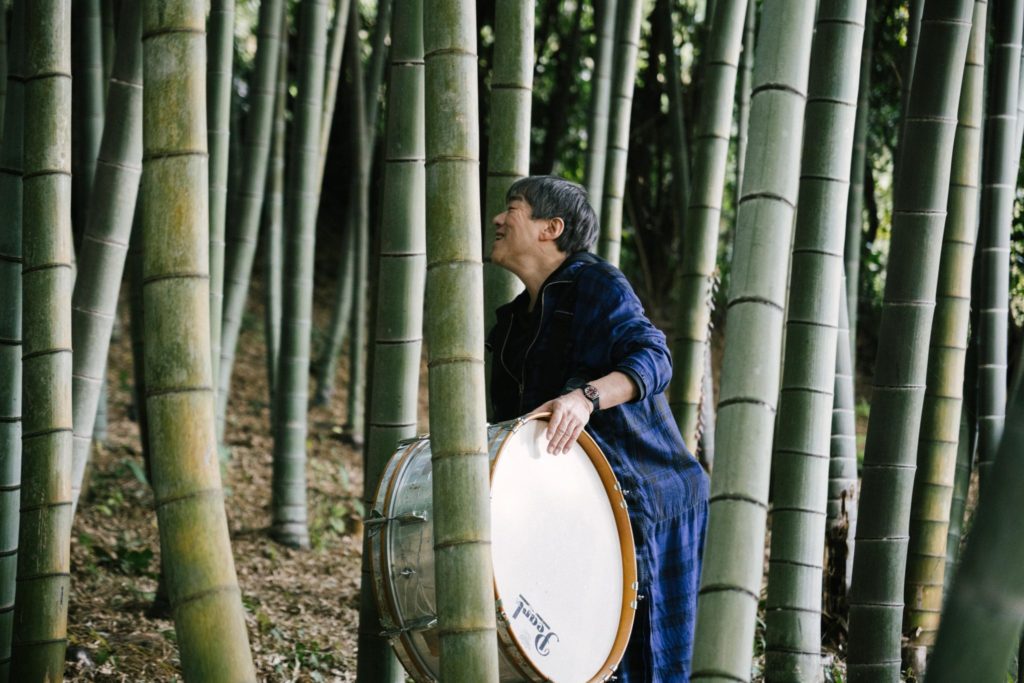
photo: Timothee Lambrecq ©Odawara Art Foundation
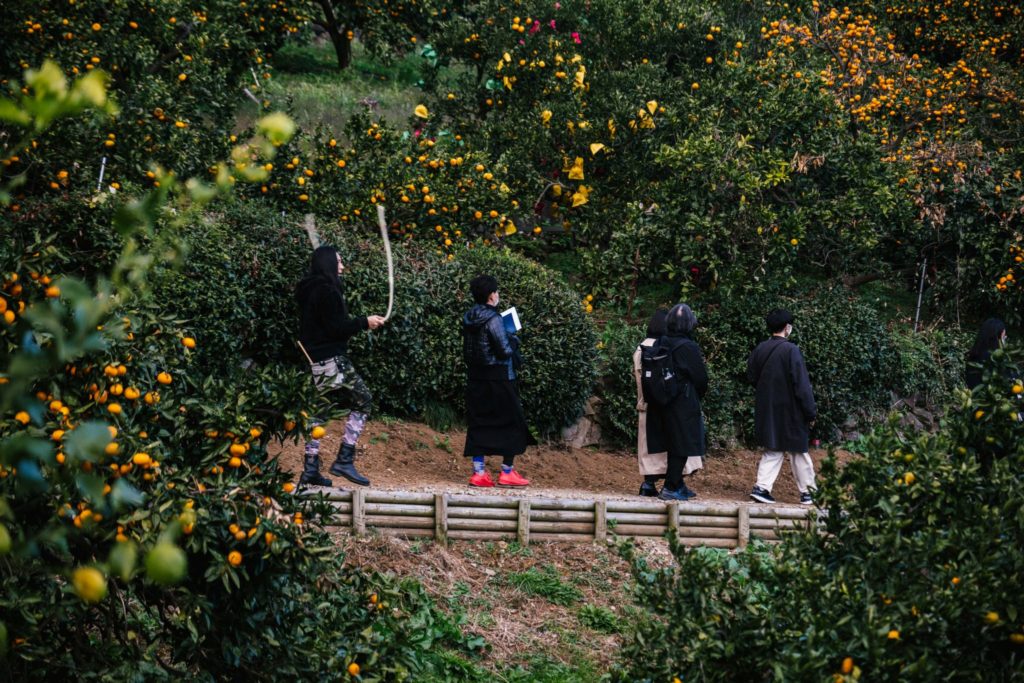
photo: Timothee Lambrecq ©Odawara Art Foundation
On that note, the Odawara Art Foundation’s logo, as I noticed on the Meigetsu Gate, is a geometrical composition combining a circle and a triangle. It represents how the horizon looks like a straight line but is actually part of a large arc, and how a triangle is a tool with which two points can be used to measure the distance to a third. If that’s the case, then maybe the roundness of the Earth is a record, too, on which countless differently shaped needles each trace their respective grooves of sound. Watching the performances, I felt like I turned from an onlooker into someone whose feet, skin, and breathing became needles on a phonograph, “playing” my surroundings.
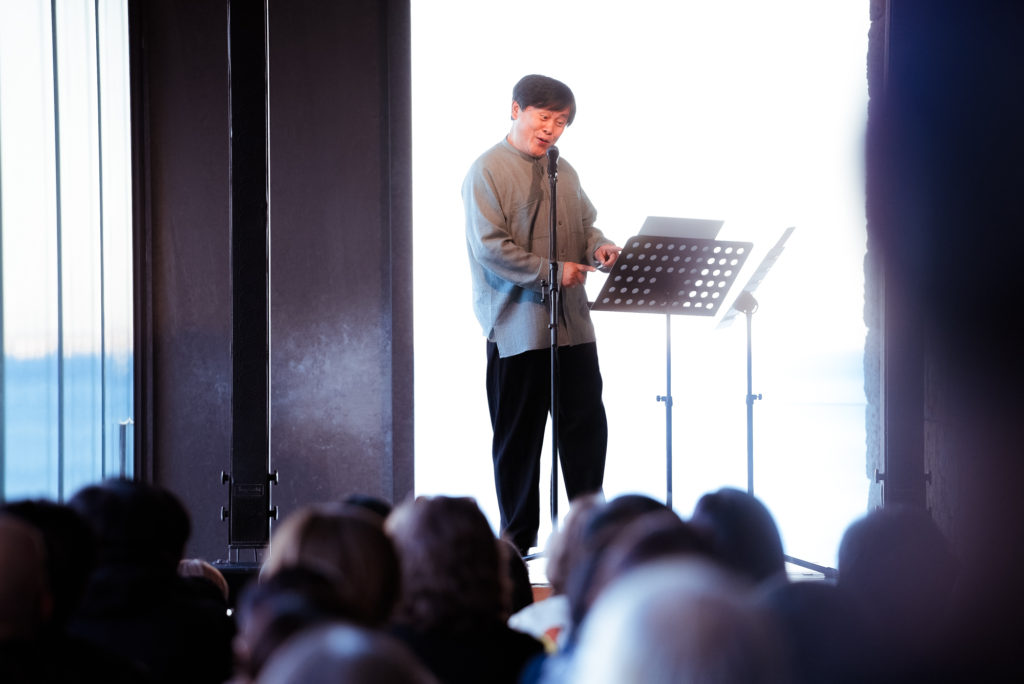
photo: Changsu ©Odawara Art Foundation
Led by Marclay, we circled the bamboo grove and finally returned to the Summer Solstice Light-Worship 100-Meter Gallery. A stage and speakers had been set up at the very end of the gallery for “No!,” a performance by Koichi Makigami. We participants excitedly took our seats on the benches placed along the gallery’s walls from the entrance toward the stage. As we were entirely in “needle” mode, with our ears as sensitized as ever, the first amplified performance of the day had an eye-opening effect. “No!” also drew on Marclay’s graphic score, and as Makigami poured his heart and soul into a hilarious performance depicting a single scene from a comic book, we simply couldn’t hold back the laughter. We were suddenly thrown right back out into the real world, as if stunned by the soundscapes emitted into the space via microphones and speakers.
Note: The way audience seating was arranged for Makigami’s performance differed between the first and second days. The aforementioned describes the situation on the second day.
Translated by Ilmari Saarinen
INFORMATION
Odawara Art Foundation Contemporary Art Project Vol. 2
“Christian Marclay: Found in Odawara”
Dates: November 27 & 28, 2021
Venue: Enoura Observatory
“Christian Marclay Found in Odawara” Video Screening
Dates: Sat. 5 February 10:30/13:00/15:30, Sun. 6 February 10:30/13:00/15:30
Museum of Contemporary Art Tokyo, B2F Auditorium


